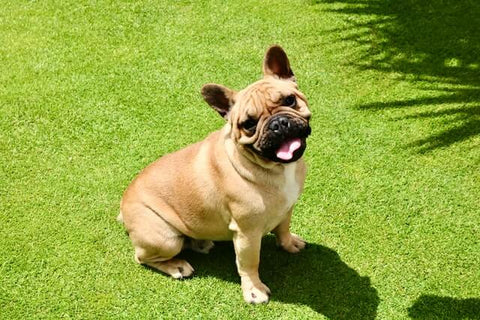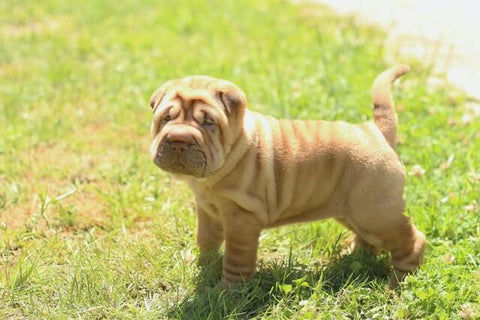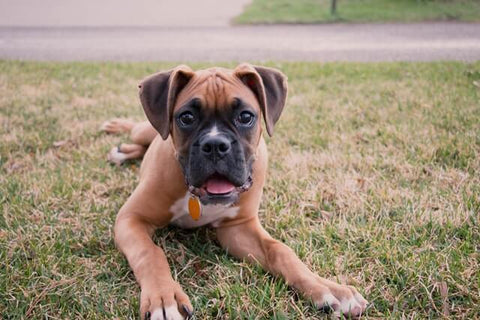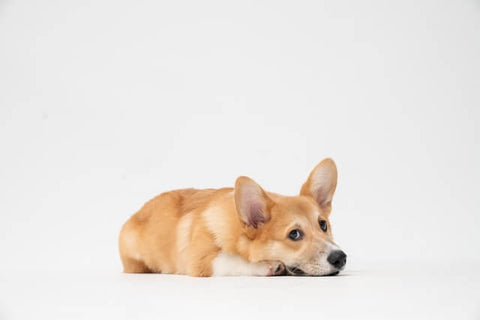Help! 13 Dog Breeds That Can't Swim

"Dogs are born to swim" is a phrase that we have all heard? The reality will turn your thoughts upside down. For some dog breeds, it is really not very good at swimming or not suitable for swimming, if you really want to give the dog to play in the water, we can properly train the dog, or put on a dog life jacket for the dog to play for a while, I believe the dog will be very satisfied.
Which Dog Breeds Can't Swim?
If you want a more detailed guide to identifying dog pups that should be kept away from water, don't worry. We'll be right there. These are the top 13 dog breeds that are not suitable for swimming.
| Dog Breeds | Height | Weight | Life Expectancy |
| France Bulldog | 11-13 inches | under 28 pounds | 10-12 years |
| Pug | 10-13 inches | 14-18 pounds | 13-15 years |
| Pekingese | 6-9 inches | up to 14 pounds | 12-14 years |
| Shar Pei | 18-20 inches | 45-60 pounds | 8-12 years |
| Boxer | 21-25 inches | 50-80 pounds | 10-12 years |
| Maltese | 7-9 inches | under 7 pounds | 12-15 years |
| Welsh Corgi | 10-12 inches | up to 30 pounds | 12-13 years |
| Dachshund | 5-9 inches | 10-32 pounds | 12-16 years |
| Basset Hound | up to 15 inches | 40-65 pounds | 12-13 years |
| Chow Chow | 17-20 inches | 45-70 pounds | 8-12 years |
| Shih Tzu | 9-10.5 inches | 9-16 pounds | 10-18 years |
| Scottish Terrier | 10 inches | 18-22 pounds | 12 years |
| Staffordshire Bull Terrier | 14-16 inches | 24-38 pounds | 12-14 years |
1.France Bulldog

French Bulldogs can't swim and should be careful whenever they are near water in case they get into trouble and face danger. French bulldogs are short-nosed and flat-faced, so their breathing is not very smooth, and because their noses are short they try to tilt their heads when swimming to keep water from choking into their nasal passages, causing the back end of their bodies to sink with force. Pls preventing them from swimming in the water for too long. Some owners say that they took their dogs to swim in the river and almost drowned.
2.Pug

Pugs are the same as bulldogs, the nose is very short, they will present a difficult breathing situation, plus the Pug is easy to fat body, if the Pug is fat, the owner is thinking of taking the dog swimming to slim down, you are advised to give up, because originally it needs to swim to tilt its head, plus the fat body, it will increase its burden, the possibility of sinking is great. Choking may lead to very serious consequences. Of course you still want to let the pug play in the pool or lake, be sure to wear a dog life jacket.
"Last summer took my pug Lucky to the park for a walk and had the sudden idea to put the he in the river for a swim, so I just threw he down. As a result, a look at the situation is not right, Lucky flopped and fell straight down. With the help of passers-by, Lucky was rescued." -Ben
3.Pekingese

On hot summer days, especially sultry days, the Pekingese can have difficulty breathing and even become ill. Don't let him move around in the direct sun during the week, and cool him down or move him to a ventilated, cool place if necessary. Likewise, like bulldogs and pugs, Pekingese can face swimming troubles, and it is important to ensure their safety when swimming.
4.Shar Pei

The Shar Pei was first used as a hunting dog, and the Shar Pei requires a high level of activity. However, they should not be over-exercised because the Shar Pei has a short nasal cavity and strenuous activity can easily cause oxygen deprivation. Shar Pei dogs are afraid of water, do not take them swimming without preparation.
5.Boxer

While Boxer's long legs may make him look like a strong swimmer, Boxers faces the same challenge as Pugs: he is considered cranially deformed. His flat face and shorter muzzle mean he will struggle to keep his face and nose above the water and will soon be exhausted, so prolonged swimming may result in shortness of breath.
6.Maltese

Small ornamental dogs like Maltese usually have tracheal problems and are more likely to have collapsed tracheas as they reach advanced age, sharing the same respiratory difficulties as short-nosed dogs. Small dogs like this are likely to die of suffocation if the dog is thrown directly into the water.
7.Welsh Corgi

The Corgi will swim, but will consume more energy than other dogs and may drown due to lack of stamina. The Corgi's short legs and large buttocks prevent it from becoming a strong swimmer, and the Corgi's short legs become the biggest obstacle to swimming, making it difficult to paddle when swimming, requiring frequent paddling, consuming energy quickly and quickly running out of stamina. If the owner forces the Corgi into the water it is likely to lead to an accident, requiring the owner to keep an eye on the Corgi's swimming condition, and if they are too far offshore they may be dangerous due to lack of stamina. If you row by boat, you must carry a dog life jacket or dog life vest.
After all, the ancestors of the Corgi are cattle herders, unlike the Golden Retriever who is a water hound, and to get your own Corgi to learn to swim, you really need to teach it, after all, the little legs are too short.
8.Dachshund

Dachshunds, like Corgis, are small and short-legged and look cute. But their short legs also become the biggest obstacle to swimming, they need to paddle frequently in the water, which will consume a huge amount of energy, they simply can not paddle for a long time. Strong swimmers are long-legged and have big arms. So don't make it any harder on your Dachshund's little short legs. Always keep a close eye on your little guy when you take him to the pool or lake.
9.Basset Hound

Many people's favorite dogs with droopy ears are also not good swimmers. Basset Hound has the longest ears in the dog world, but the sad part is that they are not floating devices. So this big boy will have trouble in the water, and the short legs will cause him to use up his strength quickly and really not be a good swimmer. Although Basset Hounds have long, sturdy bodies, their proportions are such that their hips tend to sink and their front ends tend to float, making them unable to stay level in the water. The Basset Hound's distinctive-looking redundant ears also make them susceptible to infectious diseases in the water.
10.Chow Chow

The Chow Chow's hair is thick and heavy, and the hair will become heavy after going into the water, which will make it swim with greater resistance, and many Chows have obesity, making swimming more strenuous. The hair of the Chow is dense, and if you do not blow dry in time after swimming, it is also easy to cause skin problems.
11.Shih Tzu

Shih Tzu and Maltese dog body structure although suitable for swimming, but they belong to the cold body, after the water, the dog will feel particularly cold, and even cause arthritis, rheumatism and other health problems, in addition, Shih Tzu face fur is more, after the water wet fur is very easy to cover the face, vision obstruction and cause breathing difficulties, so not suitable for swimming.
12.Scottish Terrier

The Scottish Terrier, also known as the Aberdeen Terrier, is very strong for his small frame. But facing the same problem as the Corgi, his short legs make him absolutely hopeless at swimming. His small legs simply can't support his large body, so it's best to stay on land.
13.Staffordshire Bull Terrier

This athletic dog is full of strength and loves sports, but his solid and dense muscles make him heavier and less suited for swimming. Add to this the fact that the size and weight of his head is often out of proportion to his body, and you will find it difficult to keep his head above water at all times. So don't let him get exhausted in the water, and if you plan to take him on a long boat trip in the wilderness is, have a life undershirt on hand.
Is My Dog Suitable for Swimming?
Following 3 characteristics of the dog is not suitable for swimming.
A: Dogs with short noses and flat faces
Bulldogs, pugs, and boxers are short-nosed flat-faced dogs, their noses are short & faces are flat, in order to keep breathing smoothly need to try to raise their heads high, corresponding to their bodies will sink into the water.
This kind of dog in the physiological structure is not convenient to swim, if the owner is forced to throw them into the water, the dog is easy to be choked, it is likely to drown, plus the weight of such dogs are not light, swimming in the water will have some difficulties. If they like to swim also need to take good care of it, they can not swim in the water for too long.
B: Too much bone or muscle density
A Bull Terrier like the Staffordshire Bull Terrier is very muscular, and because the body is much heavier than the head, it is difficult to ensure that its head can stay afloat for a long time. Such a special body structure determines that it is difficult to swim in the water for a long time.
C: Small short-legged
Small short-legged dogs are not suitable for swimming which is also determined by their physiological structure, small corgi and small dachshunds, and other small short-legged dogs hard to swim freely. This means they are swimming when the limbs of the high frequency of paddling, consume energy quickly, will soon run out of energy, if the owner happens not to notice their situation, it is likely to an accident.
If your dog is not suitable for swimming, but also like to swim how do it?
Owners can try these few ways to help dogs Oh.
1. Recommended for dogs swimming special dog life jacket, to prevent panic caused by sinking
2. Short-legged dogs choose shallow water area swimming, the short nasal cavity of the dog to shorten the time in the water, swimming when the owner to accompany the side
3. Dogs which afraid of cold can choose a little hot weather swimming, after swimming fully blow dry dog hair
4. Long-haired dog hair is not easy to dry after wet, if it is out and about, it is recommended to bring some professional bathing and hair blowing equipment
In addition, like the Newly vaccinated puppies, cardiopulmonary problems dogs, dogs with skin diseases, older dogs, colds, and just after vaccination is not suitable for swimming.
If your dog is too scared to go into the water, don't force them, and don't push them into the water. Even if they can't swim, they are still the cutie ONE of the family!
Pet Dog Swimming Precautions:
- 1: Observe the environment before going into the water (try not to appear strangers: dogs, water temperature should not be too low), as far as possible to let the pet dog in a relaxed state.
- 2: For pet dogs that are relatively afraid of water, you can tug the dog into the water together, from shallow to deep until the limbs leave the ground while allowing the pet dog to realize that you are right beside it.
- 3: When the pet dog is not comfortable floating in the water feeling, you can hold up its waist and belly, to give it some strength to help.
- 4: Leave your pet dog with the first pleasant: comfortable feeling, it will definitely love the sport of swimming.
- 5: Even if your dog is a strong swimmer, do not let it go into the water unsupervised.
- 6: Remember just after swimming dogs do not immediately feed Oh, you can let the dog rest for a while, and then feed some high protein, quality, and healthy dog food when calm.
"If you throw them in, they hate the water. You can try getting in the water yourself before you bring them in and give your dog a favorite treat or a favorite toy to play with." -Kathleen
Do You Usually Take Your Dog to Swim?
READ NEXT:


Leave a comment